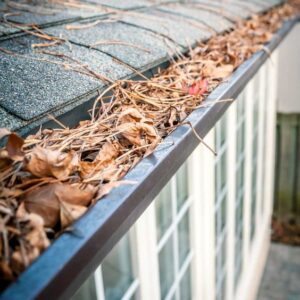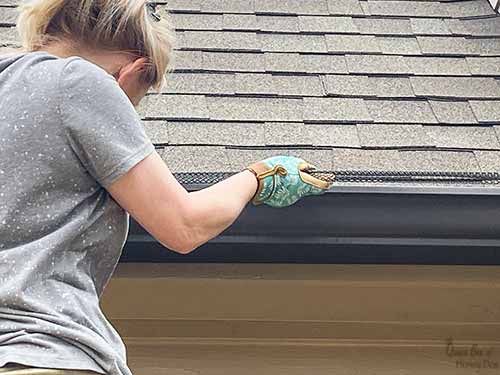
Gutter guards are vital in preventing debris buildup and maintaining efficient gutters. Regular cleaning is crucial to ensure their effectiveness and prevent potential damage. When leaves, twigs, and other debris clog the gutters, water overflow, and structural damage become imminent threats. Gutter guards act as a protective barrier, keeping the gutters clear and free-flowing. However, even with these guards in place, maintenance is still necessary. Neglecting to clean gutter guards can compromise their functionality and expose your home to water damage.
In this guide, we will explore the importance of cleaning gutter guards and provide you with practical tips to maintain their efficiency. You can learn how to clean gutters in the other guide we’ve posted.
The Different Types of Gutter Guards
Gutter guards are specialized devices designed to protect your gutters from debris buildup, ensuring smooth water flow and preventing clogs. They act as a barrier, preventing leaves, twigs, pine needles, and other debris from entering the gutter system while allowing water to pass through freely. Let’s take a closer look at the different types of gutter guards available in the market and how each one functions:
- Mesh Guards: Mesh guards consist of a fine metal or plastic mesh that covers the gutter. They are highly effective in keeping out small debris while allowing water to flow through easily. Mesh guards are versatile and suitable for various types of gutters.
- Reverse Curve Guards: Reverse curve guards, also known as surface tension guards, utilize the principle of water surface tension. They feature a curved design that allows water to adhere to the guard’s surface while guiding it into the gutter. This design prevents debris from entering the gutter, making them effective against leaves and large debris.
- Bottle Brush Guards: Bottle brush guards consist of bristles made of durable materials, such as nylon or polypropylene, which are inserted into the gutter. They work by trapping debris on top of the bristles while allowing water to pass through. Bottle brush guards are particularly effective against smaller debris like pine needles.
- Foam Guards: Foam guards are made of porous foam material that fits into the gutter. They block debris while allowing water to flow through the foam and into the gutter. Foam guards are easy to install and maintain, making them a popular choice among homeowners.
- Perforated Guards: Perforated guards feature a solid surface with small holes or perforations. These holes allow water to pass through while blocking larger debris. Perforated guards are effective in preventing leaves, twigs, and larger particles from entering the gutter.
- Snap-In Guards: Snap-in guards are designed to fit directly into the gutter, creating a protective barrier. They are made of durable materials, such as PVC or aluminum, and are easy to install and remove. Snap-in guards provide reliable debris protection and require minimal maintenance.
Each type of gutter guard offers unique benefits depending on your specific needs and the environment surrounding your home. Consider factors such as the types of debris prevalent in your area, maintenance requirements, and your gutter system’s compatibility when choosing the right gutter guard for your home.
In the next section, we will discuss the importance of regular cleaning to maintain the efficiency of your gutter guards and prevent potential damage.
Why Cleaning Gutter Guards is Important
Regularly cleaning gutter guards is crucial for maintaining their effectiveness and preventing debris buildup. Here are some key reasons why cleaning gutter guards should be a top priority:
Preventing Debris Buildup
Gutter guards are designed to keep debris out of the gutter system, but over time, some debris may still accumulate on the guards themselves. Regular cleaning ensures that any debris trapped on the guards is removed, allowing them to continue functioning optimally.
Preventing Clogging
If gutter guards are not cleaned regularly, the accumulated debris can eventually lead to clogging. Clogged gutter guards obstruct the flow of water, causing it to overflow or back up. This can result in water damage to your home’s exterior, including the siding, foundation, and landscaping.
Avoiding Water Overflow
When gutter guards are clogged, water cannot flow freely through the gutter system. As a result, water can overflow from the gutters, creating pooling around the foundation of your home. This excessive water can seep into the basement or crawl space, leading to structural damage, mold growth, and a compromised foundation.
Preserving the Gutter System
Neglecting gutter guard cleaning can put a strain on the entire gutter system. Excessive debris can add weight to the gutters, causing them to sag or pull away from the roofline. Additionally, when water overflows due to clogged gutter guards, it can cause damage to the gutters, such as rust, corrosion, and deterioration.
Maintaining Roof Health
The health of your roof is directly linked to the condition of your gutter guards. Clogged gutter guards can lead to water pooling on the roof, which can seep into the underlying layers, causing rot, leaks, and even structural damage. Regularly cleaning gutter guards helps prevent water from backing up onto the roof, preserving its integrity and extending its lifespan.
Protecting Your Home
Clean gutter guards contribute to the overall health and longevity of your home. By preventing water damage, you avoid costly repairs and potential health hazards associated with mold growth. Keeping your gutter guards clean is a proactive measure to safeguard your home’s structural integrity.
To ensure that your gutter guards continue to function effectively, it is recommended to clean them at least twice a year or more frequently if your area is prone to heavy debris. In the following sections, we will provide you with a step-by-step guide on how to clean your gutter guards properly and efficiently.
Tools and Materials Needed to Clean Gutter Guards
To effectively clean your gutter guards and ensure optimal performance, you’ll need a range of tools and materials. Here is a comprehensive list of items you will require:
Ladder
A sturdy ladder is essential for safe access to your gutters and gutter guards. Choose a ladder that is tall enough to reach the gutters comfortably and ensure it is placed on stable ground.
Gloves
Wearing gloves is highly recommended to protect your hands from debris, sharp edges, and potential contaminants that may be present in the gutter system.
Brush or Scraper
A brush or scraper is useful for removing stubborn debris and caked-on dirt from the gutter guards. Choose a brush or scraper with firm bristles or edges that can effectively dislodge and remove debris.
Garden Hose
A garden hose with a spray nozzle attachment is indispensable for rinsing the gutter guards and flushing out any remaining debris. Make sure the hose has sufficient water pressure to effectively clean the guards.
Bucket or Bag
Have a sturdy bucket or bag on hand to collect the debris that you remove from the gutter guards. This will help keep the surrounding area clean and make it easier to dispose of the debris properly.
Safety Equipment
It’s important to prioritize safety while cleaning gutter guards. Consider using safety goggles to protect your eyes from debris, and if necessary, wear a dust mask to prevent inhalation of fine particles.
Additional Tools
Depending on the specific design of your gutter guards, you may also need additional tools such as a screwdriver or pliers to remove and reattach the guards if required. Check the manufacturer’s instructions for any specialized tools recommended for your gutter guard system.
Having these tools and materials readily available will ensure that you are well-equipped to clean your gutter guards effectively and efficiently. Remember to exercise caution and follow safety guidelines throughout the cleaning process.
Cleaning Gutters with Leaf Guards

If you have leaf guards installed on your gutters, cleaning them requires a slightly different approach. Follow these step-by-step instructions to effectively clean gutters with removable leaf guards:
- Placing the Drop Cloth and Securing It: Before you start, lay a drop cloth or tarp beneath the area where you’ll be working. This will catch any falling debris and make cleanup easier.
- Ensuring Ladder Stability and Safety Precautions: Set up your ladder securely, making sure it is on stable ground and leaning against a sturdy surface. Follow proper ladder safety guidelines, including maintaining three points of contact and having someone spot you if possible.
- Removing Debris from the Guards: Begin by using a brush, scraper, or your gloved hands to remove any large debris, such as leaves, twigs, or dirt, from the leaf guards. Work your way along the gutter, removing any obstructions that could impede water flow.
- Removing the Guards and Rinsing Them if Necessary: Some leaf guards are designed to be easily removable. If your guards can be taken out, carefully detach them from the gutter. Inspect the guards for any accumulated dirt or residue and rinse them with a garden hose to ensure they are clean and functioning optimally.
- Hosing Down the Gutters and Guards: With the leaf guards removed, use a garden hose with a spray nozzle attachment to flush out the gutters. Start from one end and work your way towards the downspout, directing the water along the bottom of the gutter. This will help dislodge any remaining debris and clear the gutter system.
- Replacing the Guards and Cleaning up the Worksite: Once you have finished cleaning the gutters and the guards are thoroughly rinsed, reattach the leaf guards securely to the gutters. Ensure they are properly aligned and fastened according to the manufacturer’s instructions. Finally, remove the drop cloth or tarp and dispose of the collected debris properly.
Alternative Methods for Cleaning Gutter Guards
While the traditional method of manually cleaning gutter guards is effective, there are alternative methods you can consider based on your specific needs. Here are some alternative methods for cleaning gutter guards:
Using a Leaf Blower
- Step-by-Step Process for Cleaning Gutters with a Leaf Blower:
- Start by positioning yourself near the downspout and work your way backward.
- Use an extension tube on the leaf blower to reach the gutter guards.
- Begin blowing the leaves and debris toward the downspout.
- Continue working along the entire length of the gutter, ensuring all debris is blown away.
- Pay special attention to corners, joints, and areas where debris tends to accumulate.
- Repeat the process as necessary until the gutter guards are free from debris.
- Suitable for Regularly Cleaned Gutters with Minimal Debris Accumulation:
- This method is ideal for homeowners who clean their gutters regularly and have minimal debris accumulation.
- It provides a quick and efficient way to remove loose leaves and lightweight debris from the gutter guards.
- However, it may not be as effective for stubborn or compacted debris.
Wet/Dry Vacuum Method
- Step-by-Step Process for Using a Wet/Dry Vacuum to Clean Gutters:
- Attach the appropriate attachment or nozzle to the wet/dry vacuum.
- Position yourself near the gutter guards, starting from the downspout.
- Use the vacuum to suction out the debris from the gutter guards.
- Work your way along the entire length of the gutter, ensuring thorough cleaning.
- Empty the vacuum canister as needed to prevent loss of suction power.
- Repeat the process as necessary until the gutter guards are clean.
- Ideal for Open Gutters without Leaf Guards:
- This method works well for gutters without leaf guards or screens.
- It allows for the efficient removal of debris, including small particles and wet leaves.
- Ensure that your wet/dry vacuum is suitable for outdoor use and has sufficient power for effective cleaning.
Pressure Washer Method
- Step-by-Step Process for Using a Pressure Washer to Clean Clogged Gutters:
- Ensure you have a suitable pressure washer with the necessary attachments.
- Position yourself near the downspout and work your way backward.
- Use the pressure washer to blast water into the gutter guards, starting from the downspout.
- Direct the water along the length of the gutter to dislodge stubborn clogs.
- Exercise caution to avoid damaging the gutter system or creating a mess.
- After using the pressure washer, rinse the gutter guards with a garden hose for a thorough cleaning.
- Effective for Stubborn Clogs but Requires Careful Cleaning afterward:
- The pressure washer method is ideal for tackling tough clogs or compacted debris in the gutter guards.
- Be cautious when using high-pressure water to prevent damage to the gutter system or splashing dirty water onto the surrounding area.
- After using the pressure washer, take the time to rinse the gutter guards with a garden hose to ensure a clean and debris-free gutter system.
Manual Cleaning
- Step-by-Step Process for Manual Cleaning Using a Gutter Scoop and Hose:
- Put on your gloves and position yourself near the gutter guards.
- Use a gutter scoop or trowel to remove larger debris and scoop out any clogs.
- Place the debris in a bucket or bag for easy disposal.
- Once the larger debris is removed, use a garden hose to flush out the gutter guards.
- Direct the water along the length of the gutter to wash away any remaining dirt or smaller particles.
- Repeat the process as necessary until the gutter guards are thoroughly cleaned.
- Suitable for Heavily Clogged Gutters without Removable Guards:
- This method is effective for gutters with heavy clogs or debris that cannot be easily removed with other methods.
- It requires manual effort to remove the larger debris and flush out the gutter guards with water.
- Ensure that you have a suitable gutter scoop or trowel for effective cleaning.
Final thoughts on cleaning gutter guards
We have discussed various methods for cleaning gutter guards, including using leaf blowers, wet/dry vacuums, pressure washers, and manual cleaning techniques. Each method has its advantages and is suitable for different scenarios, depending on the condition of your gutters and the type of gutter guards installed.
Remember to prioritize safety by using stable ladders, wearing gloves, and following proper cleaning techniques. Regularly inspect your gutters for signs of damage or clogs that may require additional attention or repairs.
We hope this guide has provided you with valuable insights and practical steps to effectively clean your gutter guards. Share your experiences, tips, or questions in the comments section below. We’d love to hear from you and continue the conversation!
Last Updated on June 1, 2023

Dustin Hopkins has over 12 years in the cleaning industry, working in the past for one of the top 5 cleaning companies in the US. Currently, he is the chief editor of CleaningRank.com and the proud father of a 5-year-old, Chris.
